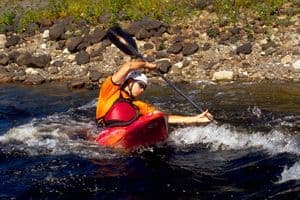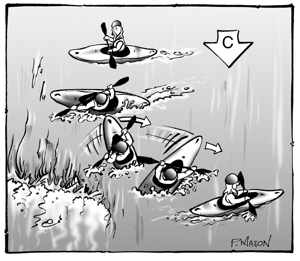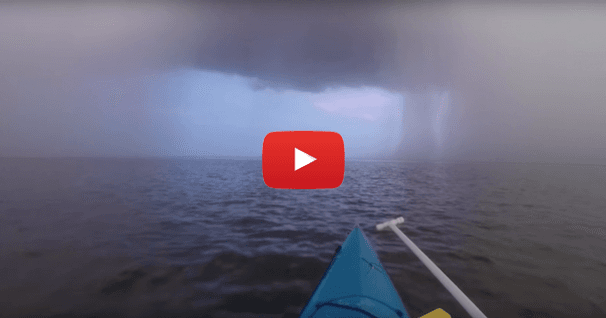Turning Midstream
The first river running skills that any paddler will learn are how to carve in and out of eddies and how to ferry across the river. Once you are comfortably doing both of these, you'll then need to consider how to make directional changes while in the main current. Being able to make crisp and confident turns midstream can mean the difference between dropping into or avoiding that monster hole that you didn't see until the last minute.

There are two types of turns that you're likely to make midstream: casual turns and aggressive turns. There really aren't many rules to consider for casual turns. Your basic sweep strokes will turn your boat quite effectively, especially if you combine a little edging with your sweeps to pivot the boat around. Near the peak of the waves is usually the best spot to turn, but is certainly not the only option. When you're at the peak of a wave, you have the best view of the rapid ahead, which obviously lets you make the most informed decision on how much to turn your kayak. As well, at the peak of the wave, a large part of your boat will be out of the water, making it much easier to turn. The reality is that any recent whitewater boat is designed to turn very well, so you don't need to restrict yourself to turning at the peak of a wave. If you need to turn, you should be able to turn your boat very effectively at any point.

When you want to turn your boat more aggressively, your best option is the pivot turn. Let's consider a situation where you are floating sideways pointing to river right, when you notice a massive hole in front of you that needs to be missed to the river left. You could just back ferry away from the hole, but let's say that you are too close to avoid it with a back ferry. Instead, you can use a stern pivot turn to pull your boat aggressively upstream and onto a ferry angle to the river left. The pivot turn that you'll use in this "combat" situation is no different than that which you use on flatwater. This means you'll aggressively lead with your head and body and pull the stern of your kayak underwater so that the bow can swing around effortlessly. To sink the stern, you need to tilt your kayak into your front sweep and throw your weight back slightly. The tricky part of this turn is making the right changes to your boat tilts. You need to maintain a downstream tilt on your kayak throughout the turn, or you'll catch your upstream edge. This means that once your sweep has pulled your bow past 12 o'clock, you need to have changed the tilt on your kayak.
You could also use a back sweep, or a Duffek stroke to initiate your pivot turn, or you could even use some combination of these strokes. The key is developing your confidence and your edge control to a point where you can use a pivot turn to make quick changes of direction in even the most chaotic whitewater. By doing this, you'll change the way you look at rapids and will open the door to more challenging whitewater.
Ken Whiting was the 1997/98 World Whitewater Freestyle Champion. He has produced an award-winning series of instructional kayaking books and DVDs, and leads kayaking trips to Chile. Look for his latest book 'The Ultimate Guide to Whitewater Kayaking', and video 'The Ultimate Guide to Sea Kayaking'. Check out www.helipress.com
Related Articles
Even if you do your research and check the weather before heading out, sooner or later every kayak…
"Snow Melts to White Water" has always been our motto - being skiers and avid river paddlers - we love…
The following is a modified excerpt from Ken Whiting's book, 'The Ultimate Guide to Whitewater…
River Bends Whenever possible, stay on the inside of bends. Rivers run fastest and deepest at the…



